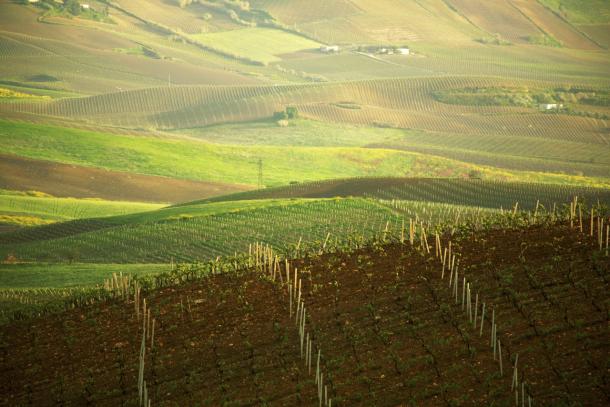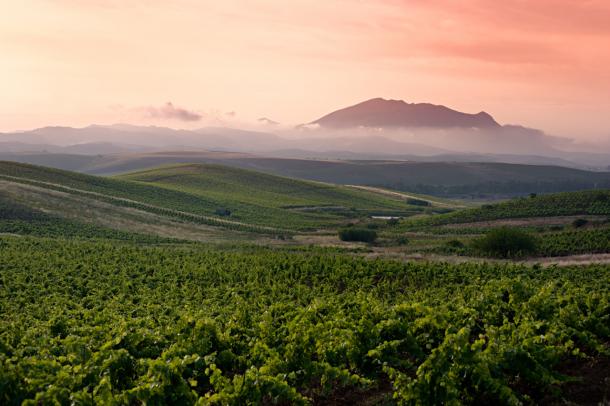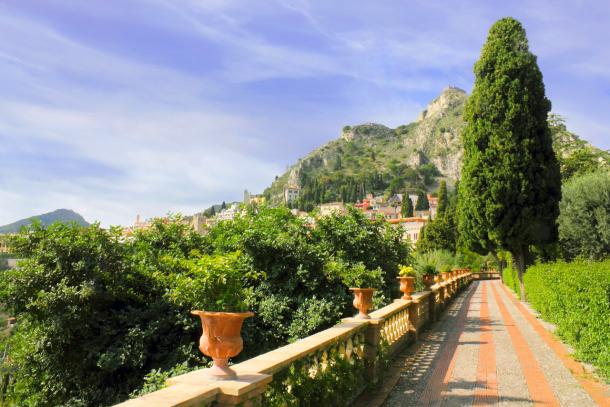The Wines of Sicily (Sicilia)
Like much of the Italian mainland, Sicily’s winemakers have moved away from producing high-volume, unremarkable wines, to focus on quality wines of great character. Its dry, well-structured red and white wines could not be further removed from the sweet Marsala and Moscato of the island’s past, and this has not gone unnoticed by international markets that have never had such a thirst for Sicilian wines.

Sicilian producers have paved the way for other Southern Italian winemakers to begin to exploit the country’s rich environmental diversity, with wines that achieve the potential first admired by the Greeks and Romans. As one of Italy’s largest wine producing regions, the island’s promise has begun to emerge with Cerasuolo di Vittoria’s promotion to DOCG classification. This lightly coloured yet powerful red made from Sicily’s own Nero d’Avola and Frappato grapes is known as Classico around Vittoria, where the grapes yield cherry-scented wines that develop notes of leather, prunes, chocolate and tobacco with age.
Another dry DOC wine of note is Bianco d’Alcamo. Made from 80% Catarratto grapes, this pale, dry white provides a fine compliment to local cuisine. The slopes of Etna provide outstanding growing conditions for many fine dry red Faro wines. Although production of wines under the Etna and Faro DOCs has been slight in recent years, Sicily’s production of quality DOC wine has increased as other appellations have been recognized on other parts of the island.

However, it is not just Sicily’s dry wines that are worthy of a mention. Sweet Moscato are still made on Etna’s slopes under the Noto and Siracusa DOC appellations. However the island’s best known sweet export is undoubtedly Marsala. For centuries, Sicily has held a proud tradition for sweet Marsala wines, which have recently undergone something of a renaissance. The best dry Vergine and Superiore Riserva wines have seen a surge in popularity among connoisseurs. Appealing as an aperitif or a dessert wine, Marsala versatility and complexity are largely unrivalled by other fortified wines.
Lesser-known sweet wines like Moscato di Pantelleria are gaining in reputation. Rich, complex and nectar-like, the Naturale and Passito Extra are highly prized, made on the island of Pantelleria, not far from Tunisia. Elsewhere on the fertile volcanic island soils, there are further reminders of Italy’s rich tradition of quality sweet wines. On the Aeolian Isles, the Malvasia grape, best known for its contribution to dry wines, is responsible for the sumptuous Malvasia delle Lipari.
The trend towards characterful wines made from indigenous grape varieties has been accompanied by the increasing importance of international varietals like Cabernet Sauvignon, Merlot and Chardonnay. Often used in blends with local grapes like the dark, muscular Nero d’Avola or delicate white Inzolia, the well-known grapes have flourished in Sicily’s climate, yielding pleasing modern wines that still display a distinctly Italian character.

The future looks bright for Sicilian winemakers as the international market for their wines continues to grow. Although around 75% of Sicily’s wine is made by co-operatives, the number of privately owned estates is rising. Reducing yields and exploring new methods of vine training have led to further improvements in quality, and a rush of investment from the north and central Italy in Sicilian vineyards demonstrates that there has never been more interest in its vibrant, charismatic and captivating wines.
Sicily DOCG wine appellation:
Cerasuolo di Vittoria
Sicily DOC wine appellation:
Alcamo or Bianco d’Alcamo, Contea di Sclafani, Contessa Entellina, Delia Nivolelli, Eloro, Erice, Etna, Faro, Malvasia delle Lipari, Mamertino di Milazzo or Mamertino, Marsala, Menfi, Monreale, Noto, Pantelleria and Moscato di Pantelleria and Passito di Pantelleria, Riesi, Salaparuta, Sambuca di Sicilia, Santa Margherita di Belice, Sciacca, Siracusa, Vittoria
Sicily IGT wine appellation:
Avola, Camarro, Fontanarossa di Cerda, Salemi, Salina, Sicilia, Valle Belice
Learn more about:
The Food and Cuisine of Sicily (Sicilia)
